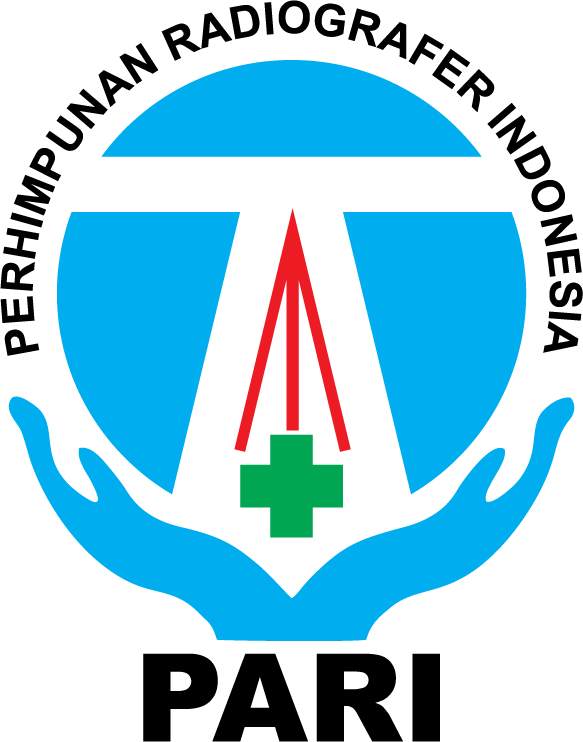Analisis Indeks Paparan Radiografi Digital Pada Pemeriksaan Radiologi Thoraks Postero Anterior Sebagai Upaya Peningkatan Proteksi Radiasi Pasien
Abstract
ABSTRACT
Backgound: Digital radiography is an easy method of radiological examination, so many radiology technicians often use high exposure factors because they are considered to speed up when processing images, this can increase the risk of excessive radiation doses in patients, currently the exposure index (IE) is feedback to radiology technicians for optimal images and low doses for patients. Objective: evaluating Fujifilm (S-Value) exposure index and entrance surface dose (ESD) thorax posterior-anterior as an effort to increase patient radiation protection using the ALARA principle,
Method: Data taken from samples with parameters 64 kVp 16 mAs to 94 kVp 2 mAs, ESD is measured using the thermoluminescent dosimeter (TLD) chip and exposure index (S-Value) from Fujifilm's direct radiography device.
Result: The relationship between S-Value and ESD has an exponential trend graph. The rise of S-Value will be followed by the ESD sequence. With the BAPETEN reference value of surface radiation dose 0.40 mGy, the minimum S-value must be achieved so that the patient's ESD does not exceed S-532 at ESD 0.39.
Conclusion: The results of this study indicate that Fujifilm's S-Value allows it to be used as an evaluation of the ESD values received by patients as an effort to increase patient radiation protection.
Keywords: Exposure index (S-Value), ESD, chest radiography, radiation protection
Keywords
Full Text:
PDFReferences
Bushong, S. C. (2015). Radiologic Science For Technologic (9th Editio). Canada: Elsevier Mosby.
Bontrager, K. (2014). Textbook of Radiographic Positioning and Related Anatomy (8th Editio). China: Elsevier Mosby.
KEMENKES. (2016). Data dan Informasi Profil Kesehatan Indonesia. Jakarta.
Rasad, S. (2010). Radiologi Diagnostik (Edisi 2). Jakarta: FKUI Publisher Hall
Seibert, J. A. (2011). The standardized exposure index for digital radiography: an opportunity for optimization of radiation dose to the pediatric population. NCBI Resources, (Pediatr Radiology). Retrieved from https://www.ncbi.nlm.nih.gov/pubmed
Mothiram, U. (2014). Digital radiography exposure indices: A review. Journal of Medical Radiation, 61(2). Retrieved from https://www.ncbi.nlm.nih.gov/ pmc/articles/PMC4175837/
Meredith, W. J. (2010). Fundamental Physics of Radiology (3rd.ed.). John Wright & Sons Ltd.
Hiswara, E. (2015). Dosis Radiasi Pasien Pada pemeriksaan Rutin Sinar-X Radiologi Diagnostik. ISSN. Retrieved from http://dx.doi.org/10.17146/jstni,2015
BAPETEN. (2016). Pedoman Teknis Penyusunan Tingkat Panduan Diagnostik Atau Diagnostic Reference Level (DRLs) Nasional. Jakarta: BAPETEN.
Seeram, Euclid. (2016) Optimizing the Exposure Indicatoras a Dose Management Strategyin Computed Radiography Journal Radiologic Technology, March/April 2016, Volume 87, Number 4
ACRRT, American Chiropractic Registry of Radiologic Technologists(2011), What does an S-value represent and how is it monitored, http://www.acrrt.com accessed 12 Juli 2021 hour 23.00 WIB
BAPETEN. (2011). Perka BAPETEN Nomor 8 Tahun 2011 Tentang Keselamatan Radiasi Dalam Penggunaan Pesawat Sinar-X Radiologi Diagnostik dan Intervensional. Indonesia
DOI: https://doi.org/10.31983/jimed.v8i1.7765
Article Metrics
Refbacks
- There are currently no refbacks.
JURNAL IMEJING DIAGNOSTIK by http://ejournal.poltekkes-smg.ac.id/ojs/index.php/jimed is licensed under a Creative Commons Attribution-ShareAlike 4.0 International License.

.png)
.png)
.png)
.png)
.png)
.png)
.png)











